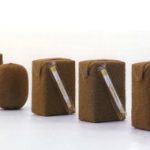Researchers in the field of genetically-modified foods will announce in an up-coming issue of The Journal of Food Science a new breakthrough in the genetic technologies responsible for the growing of some of the basic fruits and vegetables we put on our table. These technologies will literally change the shape of the fruits and vegetables we put on our table every day. These shocking photos were first leaked to the blog “After These Messages”
The above gallery depicts three fruits which were candidates in the pilot project spearheaded by an undisclosed transnational fruit company. The banana depicted shows the true power of genetically-modification to add company logos as part of the new design of these fruits. This opens the door for future use of the banana peel for the sale of advertising space for humanitarian organisations like ChildFind. The next banana you eat might have pictures of missing children grown into the banana peel.
One also cannot deny that the shape of these fruits — like that of a cube or rectangular prism — makes it easy for companies to package and ship, and also make it easier for consumers to place in their grocery bags.
The same will be happening to other fruits and vegetables. Spokespeople for the food industry say that nature does not provide us with fruits and vegetables that come in shapes that are convenient for us to carry from the market. The strawberry, like the banana, has an irregular shape, and giving it a cubic shape results in less bruising during transport. While there still needs to be some care taken for the packaging, some care still needs to be taken, since these fruits are soft and fleshy. Researchers are working on a more dense fruit and also on a banana which can be harvested in the ripened state so that consumers need not wait for days to eat under-ripe bananas, a sore point which has hurt banana sales in the past.
Researchers have also changed the shape of kiwis into small prisms, roughly the size of kid’s drink boxes. With an added artistic flair, and to reduce processing costs, they have also found a way for kiwis to grow their own straws, greatly reducing manufacturing costs at the plant level. One disadvantage is that kiwis are apparently resistant to genetic modification of its outer surface for placement of things like the company logo or the product name. This is largely due to its fibrous exterior. Strawberries face the same problem, having seeds on its exterior.
Sources at various fruit growing companies such as Chiquita and Dole vehemently deny any attempt to change the shape of fruits, which they say are trusted products which consumers have been familiar with for generations.
Many thanks to After These Messages for the photoshopping of those photos.
Views: 184



